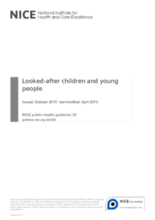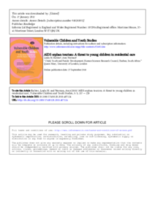Demographic Data
|
Sources: World Bank, UNDP, UNAIDS, DHS 2013 |
Displaying 13091 - 13100 of 14389
The aim of this guidance is to improve quality of life of looked-after children and young people in England, including their physical health, and social, educational and emotional wellbeing. It focuses on and encourages organisations, professionals and carers to work together to deliver high quality care, stable placements and nurturing relationships for looked-after children and young people.
Des milliers d’enfants vivent dans des centres résidentiels (orphelinats et crèches) en Haïti. a plupart d’entre eux ne sont pas orphelins mais ont été placés dans ces centres car leurs familles vivent en grandes difficultés matérielles, sociales ou économiques ou sont installées dans des localités où le manque d’accès aux services de base (santé et éducation) est un vrai défi. Leur protection est un réel enjeu pour les organismes de protection de l’enfance.
This article reviews the current discourse on what is being called a crisis of care for children, as well as literature on out-of-home/family care and its adverse impacts on child development. The article also describes an emerging “AIDS orphan tourism” and highlights its negative impacts.
Drawing on ethnographic research with five child heads and their siblings in Zimbabwe, this article explores how orphaned children living in ‘child only’ households organise themselves in terms of household domestic and paid work roles, explores the socialisation of children by children and the negotiation of teenage girls' movement.
Situation report on impact of recent floods in Pakistan on key areas of child wellbeing including child protection, education, nutrition, shelter and health.
Briefing note on supporting refugee families through asset-based family strengthening programs.
Using a range of intergovernmental, governmental, nongovernmental and media sources, this report compiled by International Social Service constitutes an unprecedented effort to document, and draw preliminary conclusions from, the course of events related to intercountry adoptions from Haiti in the first half of 2010
The Chief of Party is responsible for the overall coordination and management of a large USAID/PEPFAR program serving orphans and vulnerable children (OVC).
Retrak Ethiopia, with support from UNICEF and members from the Ministry of Women’s and Children’s Affairs, held a 4 day training aimed to equip the participants with the skills necessary to assess potential carers, match the children with the right carers, train and follow-up the carers and children, and look at some of the key issues around attachment, origins and children’s behavior.
The purpose of this paper is to give meaning and insight into some of the key drug and alcohol issues that affect children from the perspectives of the children themselves. Research shows that large numbers of children who are separated from their parents are particularly vulnerable to developing drug and alcohol problems. Special attention is paid throughout the report on children looked after by relatives, foster carers, and institutions.






